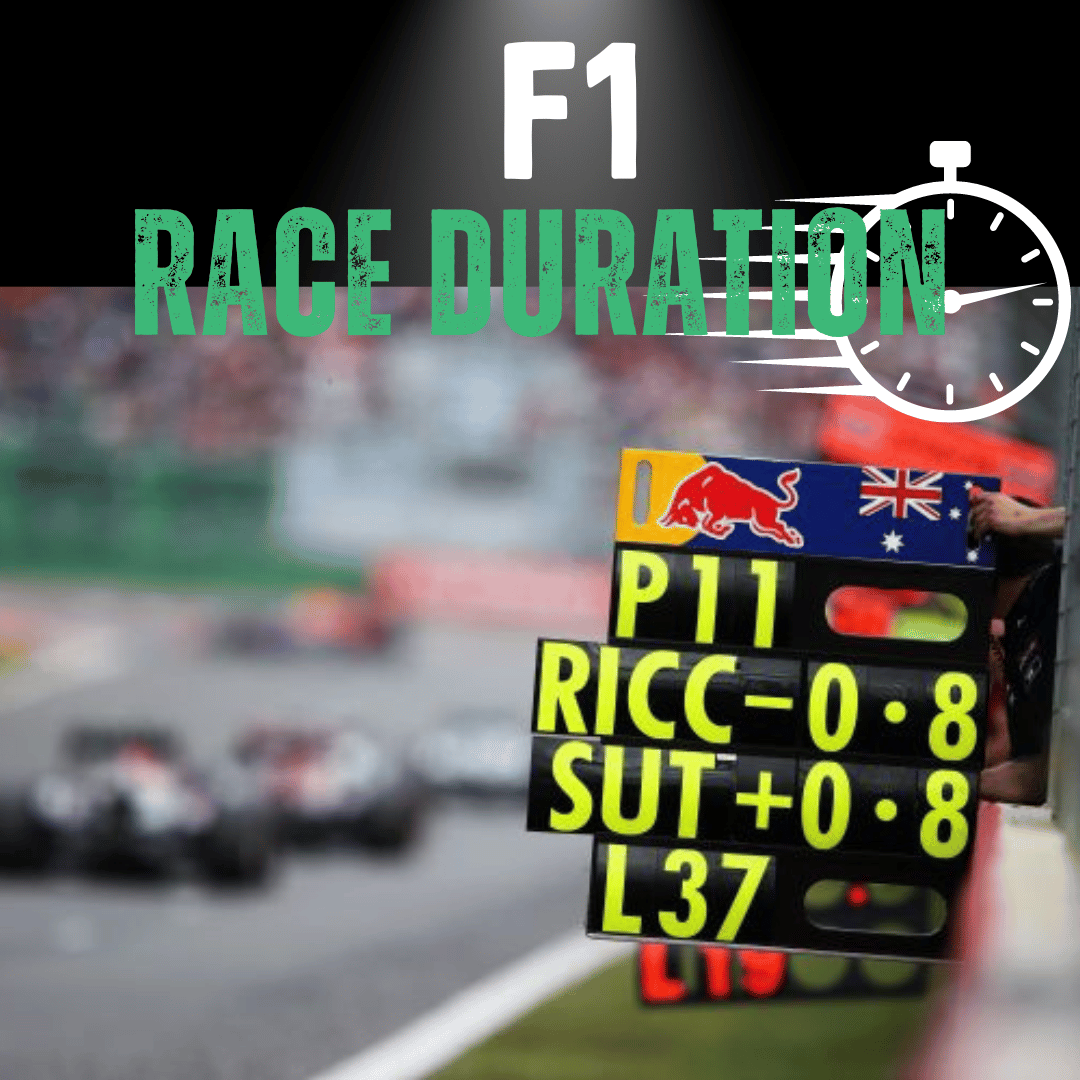Updated: 14.4.25

How Long Does an F1 Race Last?
The roar of the engines, the thrill of the overtake, and the precision of pit stops—Formula 1 is as electrifying as it is strategic. But one of the most common questions from new fans is: how long does a Formula 1 race actually last?
F1 Race Duration at a Glance
Most races last between 90 and 100 minutes. The absolute time limit is 2 hours of active racing. With delays, the entire event must conclude within 3 hours.
Race Length and Lap Count Explained
Each F1 Grand Prix is tailored to cover at least 305 km (190 miles), except for Monaco which runs 260 km due to its shorter, tighter circuit. The number of laps depends on the track length, meaning faster tracks may require fewer laps and slower ones more to reach the minimum distance.
Time Limits and Exceptions
- Standard race time: 90–100 minutes
- Hard stop: 2 hours of racing
- With delays (e.g. red flags): 3-hour total time limit
In the event the race reaches the 2-hour mark mid-lap, it will finish at the end of that lap.
How Are Laps and Timing Measured?
Timing in F1 is laser-sharp. Each car uses a transponder that communicates with timing loops buried in the track, spaced every 150–200 meters. These loops log the precise time a car passes each point, down to 1/1000th of a second—or even more accurately.
This data feeds into live lap calculations, which influence race strategy, pit stops, and even penalties.
How Many Laps Does Each Grand Prix Have?
The lap count varies by circuit. Here's a snapshot:
| Circuit | Number of Laps |
|---|---|
| Monaco | 78 |
| Hungaroring (Hungary) | 70 |
| Silverstone (UK) | 52 |
| Monza (Italy) | 53 |
| Spa-Francorchamps (Belgium) | 44 |
| Circuit de Barcelona-Catalunya (Spain) | 66 |
| Interlagos (Brazil) | 71 |
| Yas Marina (Abu Dhabi) | 58 |
| Red Bull Ring (Austria) | 71 |
| Las Vegas (USA) | 50 |
| Jeddah Corniche (Saudi Arabia) | 50 |
| Lusail (Qatar) | 57 |
F1 Strategy: Why Duration and Distance Matter
The length and structure of an F1 race shape everything from fuel strategy to tyre wear and pit stops. Teams can’t refuel during a race, so calculations on fuel load and tyre degradation are based on the projected race time and total laps.
Every lap is part of a broader game plan, and variables like rain, crashes, or a Safety Car appearance can change everything in seconds.
Track Length, Crashes & Weather: What Affects Race Time?
- Circuit length: Shorter tracks = more laps, longer time per lap.
- Weather: Rain slows speeds and may trigger delays.
- Accidents: Red flags or Safety Cars can pause or slow the race.
Shortest and Longest F1 Races Ever
- Shortest Distance: Monaco Grand Prix (260.3 km)
- Shortest Full-Distance Time: 2003 Italian GP — 1h14m (Schumacher)
- Longest Race: 2011 Canadian GP — 4h04m (Jenson Button)
- Longest by Distance: 1951 French GP — 601.8 km (shared win by Fagioli/Fangio)
Tips for Watching an F1 Race
If you’re tuning in from home, here’s how to maximise your experience:
- Start watching 10 minutes before lights out: Learn strategy and formation.
- Watch the pit stops: These can make or break the race.
- Final laps: Expect intense overtakes and drama near the end.
FAQs
What happens if a race is red-flagged before halfway?
The FIA may restart the race, nullify results, or award half-points depending on the situation.
Do all races have the same lap count?
No. Each circuit has a different lap count, determined by its length and the need to reach 305 km.
What about the Safety Car?
It can extend race duration, but fuel usage changes during this time. Teams must adapt strategy accordingly.
Does a red flag pause the clock?
Yes. The 3-hour event window pauses during red flag periods, giving time for recovery and clean-up.
Final Thoughts
F1 isn’t just about speed—it’s about precision, endurance, and brilliant strategy. Whether you’re heading to a race or catching it at home, understanding how long it lasts and why adds a whole new layer of enjoyment.
So next race weekend, bring the snacks, watch the strategies unfold, and marvel at the science behind the speed.
Want the Kids to Join the Racing Fun?
Explore our selection of kids' ride-on electric cars and let them live the F1 dream in the driveway!





Share:
What Age Is Too Late To Be An F1 Driver?
F1 Drivers Age - How Old Are F1 Drivers?